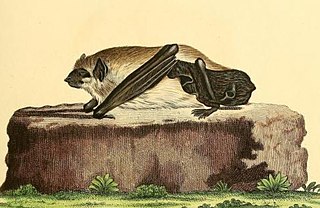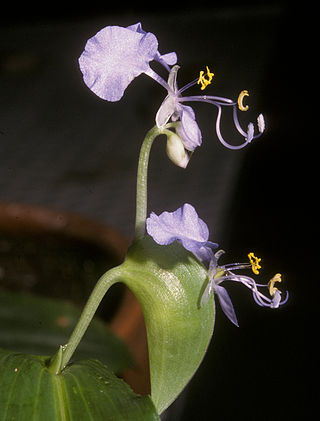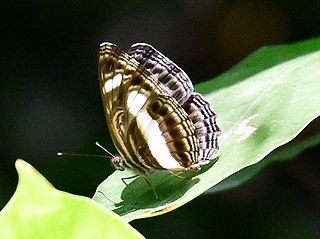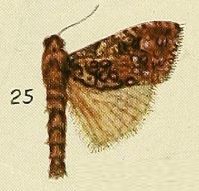
The bongo is a large, mostly nocturnal, forest-dwelling antelope, native to sub-Saharan Africa. Bongos are characterised by a striking reddish-brown coat, black and white markings, white-yellow stripes, and long slightly spiralled horns. It is the only tragelaphid in which both sexes have horns. Bongos have a complex social interaction and are found in African dense forest mosaics. They are the third-largest antelope in the world.

The white-crested turaco is a bird in the family Musophagidae, a group of African otidimorph birds. The white-crested turaco is native to riverine forest and woodland in a belt between eastern Nigeria and western Kenya. It is a common species with a wide range and the International Union for Conservation of Nature has assessed it as being of "least concern".

Schreber's yellow bat or the giant house bat, is a species of vesper bat. It is found in Benin, Democratic Republic of the Congo, Ivory Coast, Ghana, Kenya, Malawi, Mozambique, Nigeria, Senegal, Tanzania, Togo, and Zimbabwe. Its natural habitats are subtropical or tropical moist lowland forests, dry savanna, and moist savanna. It is an uncommon species and its biology is poorly known. It was first described in 1774 by the German naturalist Johann Christian Daniel von Schreber, who named it Vespertilio nigrita. It was later transferred to the genus Scotophilus, making it Scotophilus nigrita.

Commelina lukei is a monocotyledonous, herbaceous plant in the dayflower family from East Africa. This blue-flowered herb has been recorded in lowland areas of Kenya, Tanzania, and Madagascar, where it is found in a variety of habitats ranging from forests to grasslands to roadsides. Described in 2008, the species was previously confused with Commelina mascarenica and Commelina imberbis. Despite this misinterpretation, a third similar species, Commelina kotschyi, is actually most closely related to C. lukei. The plant's distinctive features include a scrambling habit, capsules with a rounded extension at the apex, appendaged seeds, clasping leaf bases throughout, and solely needle-like hairs along the upper side of the leaf's midrib. The species was named in honour of the botanist W. Q. R. Luke, whose collection of the plant served as the type specimen and allowed for a complete illustration and description.

Mylothris yulei, Yule's dotted border or the fragile dotted border, is a butterfly in the family Pieridae. It is found in Nigeria, Cameroon, Ethiopia, the Democratic Republic of the Congo, Uganda, Kenya, Tanzania, Zambia, Malawi, Mozambique and Zimbabwe. The habitat consists of submontane and montane forests and dense woodland.

Euxanthe crossleyi, the Crossley's forest queen, is a butterfly in the family Nymphalidae. It is found in Nigeria, Cameroon, Gabon, the Republic of the Congo, the Central African Republic, the Democratic Republic of the Congo, Zambia, Sudan, Uganda, Rwanda, Burundi, Kenya and Tanzania. The habitat consists of lowland evergreen forest and riverine forests.

Salamis cacta, the lilac mother-of-pearl or lilac beauty, is a butterfly in the family Nymphalidae. It is found in Senegal, Guinea, Sierra Leone, Liberia, Ivory Coast, Ghana, Togo, Benin, Nigeria, Cameroon, Equatorial Guinea, Gabon, the Republic of Congo, the Central African Republic, Angola, the Democratic Republic of Congo, Uganda, Rwanda, Ethiopia, Kenya, Tanzania, Malawi, Mozambique and Zimbabwe. The habitat consists of forests, including disturbed forest habitats.

Pseudargynnis is a monotypic butterfly genus. The single species Pseudargynnis hegemone, the false fritillary, is a butterfly in the family Nymphalidae. It is found in eastern Nigeria, Cameroon, the Republic of the Congo, Angola, the southern part of the Democratic Republic of the Congo, southern Sudan, Uganda, Burundi, western Kenya, western Tanzania, Malawi, northern Zambia, Mozambique and Zimbabwe. The habitat consists of open grassy and marshy habitats in tropical savanna and open forests.

Pseudoneptis is a butterfly genus in the family Nymphalidae. It contains only one species Pseudoneptis bugandensis, the blue sailer or blue sergeant. It is found in Guinea, Sierra Leone, Liberia, Ivory Coast, Ghana, Togo, Nigeria, Cameroon, the Republic of the Congo, the Central African Republic, Angola, the Democratic Republic of the Congo, Uganda, Kenya, Sudan, Tanzania and Zambia. The habitat consists of forest with a canopy, including dry and disturbed forests.

Neptis nemetes, commonly known as the Nemetes sailer, is a butterfly in the family Nymphalidae. It is found in western, central and eastern Africa. The habitat consists of lowland forests and riverine thicket.
Eagris sabadius is a species of butterfly in the family Hesperiidae. It is found in Uganda, Kenya, Tanzania, Malawi, Zambia, Zimbabwe and on Madagascar, Mauritius, Réunion, the Seychelles and the Comoro Islands. The habitat consists of montane forests, forests and forest margins.

Spialia ploetzi, the forest grizzled skipper, is a butterfly in the family Hesperiidae. It is found in Guinea-Bissau, Guinea, Sierra Leone, Liberia, Ivory Coast, Ghana, Togo, Benin, Nigeria, Cameroon, Gabon, the Republic of the Congo, Angola, the Democratic Republic of the Congo, Uganda, Kenya and Tanzania. The habitat consists of forests.
Mountelgonia is a genus of moths belonging to the family Cossidae, Metarbelidae.
Mountelgonia percivali is a moth of the family Cossidae. It is found from the areas east of the summits of Mount Elgon to the western highlands of Kenya. It is probably also found on the western side of Mount Elgon in Uganda. The habitat consists of dry Afromontane forest at high altitudes.
Mountelgonia abercornensis is a moth of the family Cossidae. It is found in north-eastern Zambia. The habitat consists of woodland mosaic at high elevations.
Mountelgonia thikaensis is a moth of the family Cossidae. It is found east of the eastern Great Rift Valley in the central highlands of Kenya. The habitat consists of a mosaic of scattered tree grassland and riverine forests.
Mountelgonia urundiensis is a moth of the family Cossidae. It is found on the high central plateau of Burundi. The habitat consists of forest/woodland mosaic with riverine forests at high elevations.
Mountelgonia arcifera is a moth of the family Cossidae. It is found in southern Kenya and north-central Tanzania. The habitat consists of open grasslands with shrubs and/or trees at medium to high elevations.
Mountelgonia pagana is a moth of the family Cossidae. It is found in north-eastern Rwanda. The habitat consists of a mosaic of wooded savanna, farmland and dry forests.

The Metarbelidae are a family of the Cossoidea also called the carpenter or goat moths, and is sometimes treated as a subfamily, Metarbelinae of the Cossidae. No synapomorphies are shared with the Cossidae based on adult morphology. The family Metarbelidae was first described by Embrik Strand in 1909.










